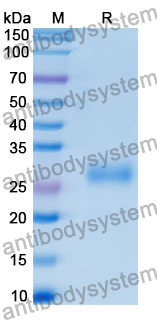Catalog No.
YHN34001
Expression system
E. coli
Species
Homo sapiens (Human)
Protein length
Met1-Lys252
Predicted molecular weight
29.95 kDa
Nature
Recombinant
Endotoxin level
Please contact with the lab for this information.
Purity
>90% as determined by SDS-PAGE.
Accession
Q9NST1
Applications
ELISA, Immunogen, SDS-PAGE, WB, Bioactivity testing in progress
Form
Lyophilized
Storage buffer
Lyophilized from a solution in PBS pH 7.4, 0.02% NLS, 1mM EDTA, 4% Trehalose, 1% Mannitol.
Reconstitution
Reconstitute in sterile water for a stock solution. A copy of datasheet will be provided with the products, please refer to it for details.
Shipping
In general, proteins are provided as lyophilized powder/frozen liquid. They are shipped out with dry ice/blue ice unless customers require otherwise.
Stability and Storage
Use a manual defrost freezer and avoid repeated freeze thaw cycles. Store at 2 to 8°C for frequent use. Store at -20 to -80°C for twelve months from the date of receipt.
Alternative Names
1-acylglycerol-3-phosphate O-acyltransferase PNPLA3, iPLA2-epsilon, C22orf20, Lysophosphatidic acid acyltransferase, Acylglycerol transacylase, Calcium-independent phospholipase A2-epsilon, Patatin-like phospholipase domain-containing protein 3, ADPN, Adiponutrin, PNPLA3
Polygenic Risk Score for Metabolic Dysfunction-Associated Steatotic Liver Disease and Steatohepatitis: A Narrative Review., PMID:40507973
Lower Frequency of PNPLA3 Polymorphism in West African Populations and Divergent Associations With Hepatocellular Carcinoma., PMID:40487275
Deep Learning Reveals Liver MRI Features Associated With PNPLA3 I148M in Steatotic Liver Disease., PMID:40478199
A comprehensive evaluation of candidate genetic polymorphisms in a large histologically characterized MASLD cohort using a novel framework., PMID:40434633
Milpa Diet for MASLD in Mesoamerican Populations: Feasibility, Advantages, and Future Perspectives., PMID:40430238
VLDL lipidomics reveals hepatocellular lipidome changes in metabolic dysfunction-associated steatotic liver disease., PMID:40408305
The Patatin-Like Phospholipase Domain-Containing 3 148M Variant Exacerbates Alcohol-Induced Liver Injury and Tumorigenesis in Mice., PMID:40350061
Widespread recessive effects on common diseases in a cohort of 44,000 British Pakistanis and Bangladeshis with high autozygosity., PMID:40306283
Cellular communication networks in fibrosis: Insights from the MASLD pig model., PMID:40304567
A novel human hepatocyte cell line to study PNPLA3-associated steatotic liver disease., PMID:40266007
Gene-based therapies for steatotic liver disease., PMID:40254880
PNPLA3 Polymorphism Is Inversely Correlated with Aortic Stiffness in Patients with Metabolic Dysfunction-Associated Steatotic Liver Disease Without Fibrosis., PMID:40244110
[Cardiometabolic and genetic factors in the progression of metabolic dysfunction-associated steatotic liver disease]., PMID:40237751
Experimental Models to Investigate PNPLA3 in Liver Steatosis., PMID:40231787
Human genetics of metabolic dysfunction-associated steatotic liver disease: from variants to cause to precision treatment., PMID:40166930
A genome-wide ATLAS of liver chromatin accessibility reveals that sex dictates diet-induced nucleosome dynamics., PMID:40161732
Association of PNPLA3 rs738409 C > G and rs2896019 T > G Polymorphisms with Nonalcoholic Fatty Liver Disease in a Turkish Population from Adıyaman Province., PMID:40101239
PNPLA3 gene variation modulates diet-induced improvement in liver lipid content in type 2 diabetes., PMID:40090039
Genetic Risk Factors for Steatotic Liver Disease After Liver Transplantation., PMID:40087975
A 4-year cohort study of the effects of PNPLA3 rs738409 genotypes on liver fat and fibrosis and gut microbiota in a non-fatty liver population., PMID:40074353
Association between single nucleotide polymorphisms in PNPLA3, TM6SF2 and MBOAT7 genes and markers of cancer aggressiveness in a Sri Lankan NASH-related HCC cohort., PMID:40065199
Function of PNPLA3 I148M-Lessons From In Vivo Studies in Humans., PMID:40052746
PNPLA3 I148M and Hepatocellular Carcinoma., PMID:40029157
Exploring the impact of graded alcohol use on atherogenic lipid profiles among Latinos with underlying chronic liver disease., PMID:40022301
In Vitro, In Vivo, and In Silico Investigation of Synbiotic-Mediated Activation of PPAR-α Curtails Nonalcoholic Steatohepatitis (NASH) in Wistar Rats by Inhibiting PNPLA3/SREBP1-c Lead Inflammatory Injury of Hepatic Cells., PMID:40017524
Diagnostic Performance of Serum Mac-2-Binding Protein Glycosylation Isomer as a Fibrosis Biomarker in Non-Obese and Obese Patients with MASLD., PMID:40002828
Transcriptomic analysis of broiler chickens reveals metabolic adaptations to a reduced crude protein diet., PMID:39983527
Temporal patterns of liver and adipose lipase abundance across the periparturient period in multiparous Holstein dairy cows., PMID:39877176
Oxidative gaseous air pollutant exposure interacts with PNPLA3-I148M genotype to influence liver fat fraction and multi-omics profiles in young adults., PMID:39864653
Metabolic dysfunction-associated steatotic liver disease in children., PMID:39848671
Genetic risk amplifies lifestyle effects on hepatic steatosis and its progression: Insights from a population-based cohort., PMID:39837741
Unlocking the influence of PNPLA3 mutations on lipolysis: Insights into lipid droplet formation and metabolic dynamics in metabolic dysfunction-associated steatotic liver disease., PMID:39832620
Lipid droplet targeting of the lipase coactivator ABHD5 and the fatty liver disease-causing variant PNPLA3 I148M is required to promote liver steatosis., PMID:39814233
A Very Low-Carbohydrate Program in Adults With Metabolic Dysfunction-Associated Steatotic Liver Disease and Phospholipase Domain-Containing Protein 3 Risk Genotype: Pre-Post Intervention Study., PMID:39801107
AZD2693, a PNPLA3 antisense oligonucleotide, for the treatment of MASH in 148M homozygous participants: Two randomized phase I trials., PMID:39798707
Genetic Risk Factors for Metabolic Dysfunction-Associated Steatotic Liver Disease., PMID:39774124
Genetic predisposition of metabolic dysfunction-associated steatotic liver disease: a population-based genome-wide association study., PMID:39755997
Deep metabolic phenotyping of humans with protein-altering variants in TM6SF2 using a genome-first approach., PMID:39687601
Genetic Risk, BMI Status, BMI Change Patterns, and the Risk of Steatotic Liver Disease and Liver Enzyme Elevation in Chinese Adults., PMID:39683606
PNPLA3 in Alcohol-Related Liver Disease., PMID:39679853
Type 2 diabetes and the minor allele of PNPLA3 consistently identify high-risk metabolic dysfunction associated steatotic liver disease., PMID:39675485
PNPLA3 and SAMM50 variants are associated with lean nonalcoholic fatty liver disease in Asian population., PMID:39638042
Lipid droplet targeting of ABHD5 and PNPLA3 I148M is required to promote liver steatosis., PMID:39605541
Targeting PNPLA3 to Treat MASH and MASH Related Fibrosis and Cirrhosis., PMID:39605307
Interaction Between PNPLA3 and SIRT5 Genetic Variants in Association with Liver Fibrosis Severity in Patients with Metabolic Dysfunction-Associated Steatotic Liver Disease., PMID:39596570
Statin-associated regulation of hepatic PNPLA3 in patients without known liver disease., PMID:39560367
PNPLA3 I148M Interacts With Environmental Triggers to Cause Human Disease., PMID:39559944
PNPLA3(148M) is a gain-of-function mutation that promotes hepatic steatosis by inhibiting ATGL-mediated triglyceride hydrolysis., PMID:39550037
Impact of PNPLA3 in Lean Individuals and in Cryptogenic Steatotic Liver Disease., PMID:39540675
Role of metabolic dysfunction-associated steatotic liver disease and of its genetics on kidney function in childhood obesity., PMID:39521922

